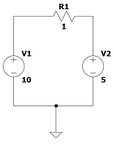electronicsman
Full Member level 5
Common circuit i have seen but never thought let us say two power sources 10v and 5v in series with 5 ohm resistor in between. The current is 1amp, the net power by 10v source is 10w delivered but for the second source it is 5watt absorbed. The 5v being source how it can absorb ? I understand the resistor will dissipate what about source ?
